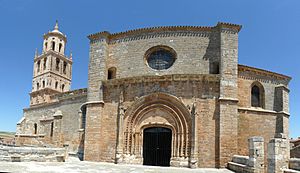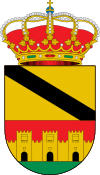Santa María del Campo facts for kids
Quick facts for kids
Santa María del Campo
|
|||
|---|---|---|---|
|
Municipality and town
|
|||

Nuestra Señora de la Asunción collegiate church (13th-18th century)
|
|||
|
|||
| Country | Spain | ||
| Autonomous community | |||
| Province | |||
| Comarca | Arlanza | ||
| Area | |||
| • Total | 60.32 km2 (23.29 sq mi) | ||
| Elevation | 815 m (2,674 ft) | ||
| Population
(2018)
|
|||
| • Total | 537 | ||
| • Density | 8.903/km2 (23.057/sq mi) | ||
| Time zone | UTC+1 (CET) | ||
| • Summer (DST) | UTC+2 (CEST) | ||
| Postal code |
09342
|
||
| Website | http://www.santamariadelcampo.es/ | ||
Santa María del Campo is a small town and a municipality in the Province of Burgos, Spain. It's located in a wine-making area called Ribera del Arlanza. The town is about 22 kilometers away from Lerma.
Contents
A Look at Santa María del Campo's Past
Santa María del Campo has a long history. It was first known in the 12th century as "Saint Maria of the Perch." The town was rebuilt in 1440 in a style called Lombard-Gothic. This style combines elements from both Lombardy (a region in Italy) and Gothic designs.
The town is built on high ground, more than 800 meters (about 2,600 feet) above sea level. The municipality of Santa María del Campo covers about 60 square kilometers (23 square miles). It also includes the nearby town of Escuderos.
Exploring the Church's Design
The main church in Santa María del Campo is built in the shape of a Latin cross. It has three main sections, called naves, and two chapels on each side. The church shows two main periods of building. The older part, near the front, dates back to the 13th century. It even has a small cloister from 1425.
Later, in the late 15th century, the church was made taller and brighter. A famous part of the church is its large tower. It was built by Diego de Siloé in 1527. He won a competition against another artist, Felipe Bigarny, to design it.
The church's main entrance has a special curved ceiling called a barrel vault. This vault is decorated with square panels. Outside, the entrance is framed by columns and has spaces for statues. The church has three entrances in total. The main one is under the tower, and two others are on the sides. The northern entrance was carved starting in the 16th century.
Inside, the choir (where singers sit) was moved in 1757 to the central nave. The stone work from the late 15th century has cool geometric patterns. The area around the main altar, called the presbytery, is higher than the rest of the church. There's also a plaster pulpit (a raised platform for speaking) from the early 16th century.
Discovering the Church's Art
The church's inside is simple but beautiful. It holds many interesting paintings, frescoes (wall paintings), and stucco (decorative plasterwork). These were created by local artists in the 16th and 17th centuries.
Some famous artworks include:
- Mercy and Musician Angels by Giovanni Battista Crespi.
- The Madonna del latte by Tommasino from Mortara. This painting is very special to the town because people believe miracles have happened because of it.
The main altarpiece (a large artwork behind the altar) was made in the 18th century by José Valdán and Joaquín de Villandiego. Six old paintings from different altarpieces were put together to create the current altar in front of the church's main door. Two of these paintings, The Beheading of Saint John the Baptist and The Baptism of Christ, are works by the famous artist Pedro Berruguete.
Celebrating Local Traditions
Santa María del Campo has several fun festivals throughout the year:
- San José Festival: This festival takes place from March 18 to 19.
- Patron Saint Festivities: In mid-August, the town celebrates its patron saints, Our Lady of the Assumption and San Roque.
- Pilgrimage of Our Lady of Squires: This special event is held on September 24.
See also
 In Spanish: Santa María del Campo para niños
In Spanish: Santa María del Campo para niños



